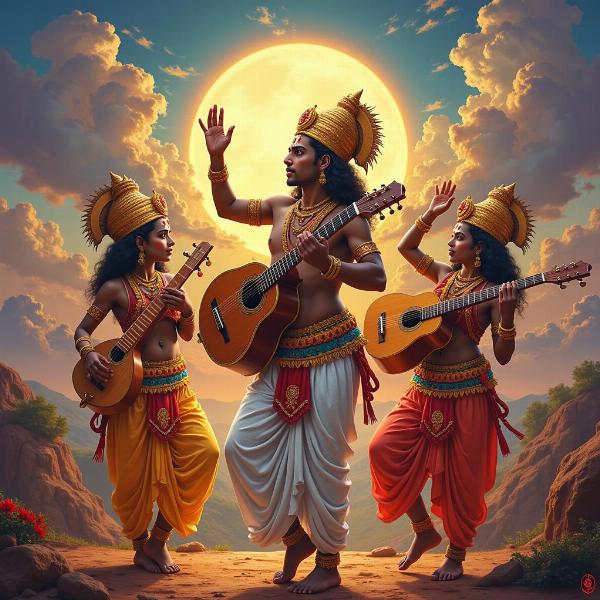The term “kinnar meaning in hindi” often leads to curiosity about its various interpretations and cultural significance. This article delves deep into the meaning of kinnar, exploring its mythological roots, social implications, and evolving understanding in modern Indian society. We’ll uncover the nuances of this term and address common questions surrounding its usage.
Understanding the Multiple Meanings of Kinnar
The word “kinnar” (किन्नर) holds a rich tapestry of meanings in Hindi. Primarily, it refers to celestial beings in Hindu mythology, often depicted as musicians and dancers in the courts of the gods. These mythical beings are neither male nor female, holding a unique and revered position in the spiritual realm. However, in contemporary India, “kinnar” has also become a commonly used term for the transgender community. This usage reflects a complex interplay between ancient mythology and modern social dynamics. The term can also sometimes be used poetically to describe someone with androgynous qualities or a captivating, otherworldly charm.
 Mythological Depiction of Kinnars
Mythological Depiction of Kinnars
Kinnar in Hindu Mythology: Divine Beings and Messengers
Hindu mythology portrays kinnars as beings of great beauty and artistic talent. They are believed to possess supernatural powers, including the ability to bless or curse. Often depicted as intermediaries between gods and humans, they are seen as messengers and guardians of sacred spaces. Their association with music and dance underscores their connection to the divine and their role in celebrating auspicious occasions. Stories of kinnars are woven into various Hindu epics and scriptures, highlighting their significance within the broader religious context.
Kinnar in Modern India: The Transgender Community
In present-day India, the term “kinnar” is widely used to refer to individuals who identify as transgender. While the mythological association adds a layer of respect and reverence, it’s crucial to recognize that this usage encompasses a diverse community with varied experiences and identities. The transgender community in India faces significant social and economic challenges, including discrimination and marginalization. Using the term “kinnar” can be both empowering and stigmatizing, depending on the context and individual perspectives.
The Nuances of Usage: Respect and Sensitivity
Understanding the nuances of using “kinnar” is paramount. While its mythological roots add a layer of mystique and reverence, it’s essential to approach the term with sensitivity and respect, particularly when referring to the transgender community. It’s important to remember that language evolves, and the meaning of words can shift over time. Therefore, being mindful of the context and the individual’s preferred identification is crucial for respectful communication.
Addressing Common Questions about Kinnar
Many questions arise surrounding the usage and meaning of “kinnar.” Let’s address some of the most common queries:
What is the difference between kinnar and hijra?
While both terms are often used interchangeably, “hijra” typically refers to a specific transgender community in South Asia with a distinct history and cultural practices. “Kinnar” is a broader term that encompasses various transgender identities and has its roots in mythology.
Are kinnars considered sacred?
In Hindu mythology, kinnars are revered as divine beings. However, the contemporary usage of the term to refer to the transgender community does not necessarily imply inherent sacredness. It’s more about recognizing a connection to a historical and cultural narrative.
Conclusion: Appreciating the Complexity of “Kinnar”
The term “kinnar meaning in hindi” encompasses a fascinating blend of mythology, social dynamics, and evolving language. Understanding its multifaceted nature is crucial for respectful and informed communication. From its origins in Hindu mythology to its current usage in reference to the transgender community, “kinnar” carries a rich and complex history.
FAQs:
- What does kinnar symbolize in Hindu mythology? Kinnars symbolize divine musicians, dancers, and messengers of the gods.
- Is kinnar a derogatory term? While not inherently derogatory, its usage regarding the transgender community requires sensitivity and respect for individual preferences.
- How is kinnar different from other terms for transgender individuals? “Kinnar” is rooted in Hindu mythology and is prevalent in certain regions of India, while other terms may have different cultural origins and geographic usage.
- Are there any specific rituals associated with kinnars? Yes, certain communities have specific rituals and traditions related to kinnars, often linked to blessings and auspicious occasions.
- What are the challenges faced by the kinnar community in India? The kinnar community faces social stigma, discrimination, and limited access to education, employment, and healthcare.
- How can we promote respectful and inclusive language when referring to the kinnar community? Using preferred pronouns, avoiding generalizations, and being mindful of the individual’s identity are crucial steps.
- Where can I learn more about the history and culture of the kinnar community? Academic resources, community organizations, and documentaries can provide further insights.
Meaning-Hindi.in is your trusted partner for professional Hindi translation services, catering to a diverse range of needs, from business and legal documents to technical manuals and website localization. We specialize in accurate and culturally sensitive translations, ensuring your message resonates effectively with your target audience. Whether you need certified translation, educational material translation, or quick turnaround times, our expert team is here to assist you. Contact us at [email protected] or call us at +91 11-4502-7584. Meaning-Hindi.in is committed to bridging language barriers and facilitating seamless communication across cultures.